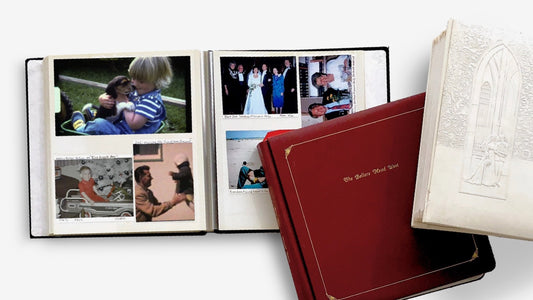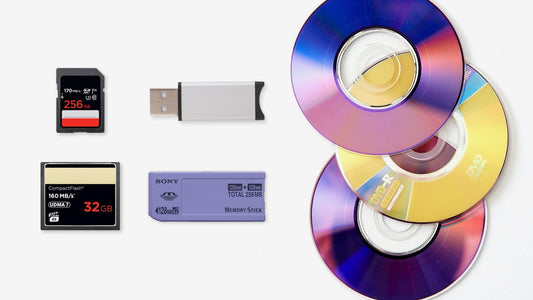You wouldn’t keep the only key to your house and your car on the same keychain, right? It’s common sense to have a backup, just in case. The same logic applies to your family’s digital memories, which are far more valuable than any physical object. This simple idea is the foundation of a powerful data protection strategy used by experts worldwide. It’s called the 3 2 1 backup rule, and it’s a simple recipe for peace of mind: keep three copies of your files, on two different types of storage, with one of those copies located off-site. It sounds technical, but it’s surprisingly easy to set up.
Key Takeaways
- Follow the 3-2-1 Rule for Total Protection: The core of a solid backup plan is simple: maintain three copies of your memories, store them on two different types of media (like a hard drive and the cloud), and ensure one copy is kept off-site to protect against local disasters.
- Combine Physical and Cloud Storage: A reliable system uses different types of storage for maximum security. Use an external hard drive for quick, local access and a cloud service for your essential off-site copy that protects against fire, theft, or hardware failure.
- Make Your Plan Effortless with Automation and Testing: A backup plan only works if you stick with it. Set up your software to run backups automatically, and then periodically test your system by recovering a random photo or video to ensure everything is safe.
What is the 3-2-1 Backup Rule?
If you’ve ever felt a pang of panic thinking about losing your family’s digital photos and videos, you’re not alone. From accidental deletions to hard drive failures, digital memories can feel fragile. That’s where the 3-2-1 backup rule comes in. It’s a straightforward, time-tested strategy that data professionals use, but it’s simple enough for anyone to follow at home. Think of it as your family’s digital safety net, ensuring that your precious moments—from your parents’ wedding video to your child’s first steps—are protected from just about any mishap.
What the "3-2-1" Actually Means
The 3-2-1 backup rule is a simple data protection strategy. It means keeping three copies of your data on two different types of storage, with one copy stored off-site. For example, your original digitized home movie is copy one. A second copy could live on an external hard drive, and a third in the cloud. This "off-site" cloud copy is crucial—it protects your memories from local disasters like a fire or flood, ensuring you don't lose everything if something happens at home.
Why This Simple Rule is So Important
This rule is so important because technology can be unpredictable. Hard drives fail and laptops get stolen. If your only copy of a priceless photo album is on one device, it’s at risk. Spreading your files across different locations creates redundancy, so if one backup fails, you have others to rely on. As the experts at Backblaze explain, backing up your computer to an external drive and then backing up both to the cloud achieves a 3-2-1 setup. It’s a simple plan that provides serious peace of mind.
How the Rule Has Evolved
The 3-2-1 rule has been a best practice for years, adapting as technology changes. It started in the business world but is more relevant than ever for families. The rise of affordable cloud storage and new digital threats like ransomware has led to new interpretations. As data security firm Cohesity notes, the rule has "evolved into several different flavors" to meet modern challenges. For families, this means the classic 3-2-1 approach is a fantastic starting point, with even more robust options now available to protect your memories.
Taking It a Step Further: The 3-2-1-1-0 Rule
For ultimate protection, consider the 3-2-1-1-0 rule. It adds two key steps. The extra "1" stands for one "air-gapped" copy—a backup that’s stored offline and disconnected from any network, like an external hard drive you only plug in when backing up. This is your best defense against ransomware. The "0" stands for zero errors, reminding you to regularly test your backups to ensure they work. After you transfer your videos, adopting this gold standard is the best way to ensure your memories last for generations to come.
The Key Parts of a Family Backup Plan
A solid backup plan doesn't have to be complicated. In fact, the best ones are simple and built on a few core principles. Think of it as creating a safety net for your most precious memories. By following a clear structure, you can protect your family’s digital legacy from hard drive failures, accidents, or even natural disasters. The goal is to make sure that no single event can wipe out your entire collection of photos and videos. Let’s walk through the essential components that make up a reliable family backup plan.
Create Three Copies of Your Data
The first step is to have three copies of every important file. This might sound like a lot, but it’s the foundation of a secure system. Your first copy is the original file—the digital photo on your computer or the home movie you just had digitized. The other two are backups. Why three? Because things happen. A single backup can fail, get lost, or become corrupted. Having a third copy dramatically reduces the risk of losing a memory forever. Your journey starts by creating that first high-quality digital original, often by using a photo transfer service to convert your physical media.
Use Two Different Types of Storage
Your three copies of data shouldn't all live in the same kind of place. The rule of thumb is to use at least two different types of storage media. This protects you if one type of technology fails or becomes obsolete. For example, you could keep one copy on your computer’s internal hard drive and a second copy on an external hard drive. Other options include USB flash drives or a Network Attached Storage (NAS) device. By diversifying your storage, you ensure that a failure specific to one format—like a hard drive crash—won’t take out all your copies at once.
Keep One Copy Off-Site
This is the most important rule for protecting your memories from a local disaster like a fire, flood, or theft. At least one of your backup copies needs to be stored in a different physical location. This "off-site" copy is your ultimate failsafe. You could keep an external hard drive at a trusted family member’s house or in a safe deposit box. An even easier and more popular option is using a cloud storage service. When you use a digital media transfer service, you often get access to cloud storage, which automatically creates that secure, off-site copy for you.
How to Choose the Right Storage Mix
So, how do you put this all together? A great, practical setup for most families looks like this:
- Copy 1 (Primary): Your photos and videos live on your main computer or laptop.
- Copy 2 (Local Backup): You keep a backup on an external hard drive that you store at home.
- Copy 3 (Off-site Backup): You use a cloud storage service for your third copy.
This mix covers all your bases. Your computer gives you easy access, the external drive provides a quick local backup, and the cloud protects your files from any disaster that could happen at home.
Keep Your Family's Files Private with Encryption
Your family’s memories are private, and your backup plan should keep them that way. Encryption is the process of scrambling your data so that only someone with the correct password or key can view it. Most reputable cloud storage providers automatically encrypt your files, adding a powerful layer of security. You can also buy external hard drives with built-in hardware encryption. For ultimate protection, you can create an "air-gapped" backup—a drive that is completely disconnected from your computer and any network when you’re not actively backing up files. This makes it impossible for online threats to reach it.
Put Your Backup Plan into Action
A plan is only as good as its execution, so let's get yours up and running. Putting a system in place for your family’s memories doesn't have to be complicated or time-consuming. The goal is to create a simple, reliable process that works in the background to protect your most important files. Think of it as setting up a digital safety net for everything from your child’s first steps captured on a camcorder to last year’s holiday photos.
Once you have your precious home movies digitized through a video transfer service, you have the perfect "master copy" to protect. From there, it’s all about creating your copies and putting them in safe places. The following steps will walk you through setting up your system, creating a schedule that works for you, and making the whole process a simple, stress-free part of your family's routine.
Set Up Your Family's Backup System
This is where the 3-2-1 rule comes to life. Your first step is to establish where your three copies will live. Let’s start with your primary copy—the files on your main computer or laptop. For your second copy, use a different type of storage, like an external hard drive. This protects you if your computer fails. Finally, your third copy needs to be off-site. A cloud storage service is perfect for this, as it keeps your files safe from local disasters like fire or theft. This simple structure ensures that no single event can wipe out your entire collection of family memories.
Create a Simple Backup Schedule
Consistency is key to a successful backup plan. You don’t need to back up your files every day, but you should do it regularly to protect your most recent memories. For most families, a weekly or bi-weekly schedule works well. Pick a specific day and time—like Sunday evening—and put it on your calendar as a recurring event. Sticking to a schedule ensures that new photos from a birthday party or videos from a school play are quickly protected. It only takes a few minutes, but this simple habit makes a huge difference in keeping your digital archive up to date.
Automate Your Backups to Save Time
The easiest way to stick to your schedule is to take yourself out of the equation. Many backup tools can be set up to run automatically, saving you time and effort. Cloud storage services often have desktop apps that sync your files in the background, and operating systems have built-in tools (like Time Machine on a Mac or File History on Windows) that can automate backups to an external drive. Once you set up your automation, your files will be copied without you having to lift a finger, ensuring your backup plan is always working.
Test Your Backups Regularly
A backup you can’t restore is just a waste of space. That’s why it’s so important to test your system every few months. Don’t worry, this is easier than it sounds. You don’t need to restore everything; just pick a few random files—a photo, a short video—and try to recover them from your external drive and your cloud storage. This quick "fire drill" confirms that your files are being copied correctly and that you know how to access them when you need them most. It’s a small step that provides huge peace of mind.
Get the Whole Family Involved
Protecting your family’s legacy can be a shared responsibility. Talk to your family about why you’re backing up your photos and videos. Show older kids how the system works and explain the importance of your shared memories, from old 8mm films to the latest smartphone pictures. When everyone understands the value of these digital keepsakes, they’re more likely to help protect them. Making backups a family habit ensures that your memories will be safe and accessible for generations to come, creating a tradition of preservation that everyone can be a part of.
The Best Backup Tools for Your Home
Choosing the right tools is the secret to making your backup plan easy to manage. You don’t need a complex, enterprise-level system to protect your family’s digital files. The best setup is one you’ll actually use consistently. The goal is to find a mix of physical and cloud-based tools that work together seamlessly, automating as much of the process as possible so you can set it and forget it. Let's look at some simple, reliable options that are perfect for home use.
Physical Storage Options
Physical storage is your first line of defense and covers the "two different media" part of the 3-2-1 rule. The most common and reliable choice is an external hard drive. They offer a lot of storage for a reasonable price and are simple to use—just plug one into your computer. You can dedicate one drive to back up your main computer and another for your most precious files, like your digitized home movies and photos. If you back up your computer to an external hard drive and then back up both of those to the cloud, you’ve successfully created a 3-2-1 system.
Cloud Storage Platforms for Families
Cloud storage is the perfect solution for your off-site copy. It protects your memories from local disasters like fire, flood, or theft. Think of it as a secure digital vault located somewhere else entirely. Services like Google Drive, Dropbox, iCloud, and Amazon Photos offer family plans that make it easy to share storage space and manage files collaboratively. When you choose a cloud service, you’re ensuring that at least one backup is stored remotely and protected from any local hardware failure, keeping your family’s legacy safe no matter what happens at home.
Simple Backup Software to Use
The best way to stick to a backup plan is to automate it, and backup software is what makes that happen. Your computer likely already has a great tool built-in: Time Machine for Macs and File History for Windows are both excellent, user-friendly options. For a more comprehensive solution that includes cloud backup, services like Backblaze are fantastic. They run quietly in the background, creating copies of your files automatically. The key is to find a tool that lets you automate your backups so you can regularly monitor and test them without adding another task to your to-do list.
Security Features to Look For
When you’re storing decades of family memories, from old film reels to recent digital photos, security is non-negotiable. For physical drives, look for models that offer hardware encryption. For cloud services, prioritize providers that use end-to-end encryption, which means only you can access your files. Always enable two-factor authentication (2FA) for an extra layer of protection on your account. When selecting a cloud provider, it's wise to look for one with geographically distributed, highly secure data centers to ensure your backups are always safe and available when you need them.
Common Backup Problems (and How to Solve Them)
Putting a backup plan into action is a huge step, but it’s normal to hit a few bumps along the way. Life gets busy, technology can be tricky, and questions about cost and security are bound to come up. Think of these common challenges not as roadblocks, but as opportunities to fine-tune your strategy. With a few simple solutions, you can overcome these hurdles and create a backup system that works seamlessly for your family, ensuring your memories are protected without adding stress to your life.
Managing Your Storage Space
Once you begin digitizing your home movies and photos, you’ll notice that digital files, especially high-quality videos, take up a lot of room. It can feel like you’re constantly running out of space. The best way to handle this is to be strategic. The 3-2-1 backup strategy is a great framework because it distributes your files, so you aren’t relying on a single, massive hard drive. Using a cloud service for one of your copies can also free up local space. After you complete a photo transfer, take a moment to organize the new digital files. Delete duplicates and blurry shots to keep your collection manageable and your storage needs in check.
How to Back Up on a Budget
Protecting your family’s legacy shouldn’t feel like a financial burden. While some backup solutions come with monthly fees, there are plenty of ways to back up your files without breaking the bank. External hard drives are a great starting point, as they’re a one-time purchase that can hold thousands of photos and videos. For your off-site copy, you don’t necessarily need a paid subscription. You could keep a second external drive at a trusted friend or family member’s house. Many cloud storage services also offer free starter plans that are perfect for storing your most important files.
Keeping Your Family's Data Secure
Your family photos and videos are personal, and keeping them private is a top priority. The 3-2-1 rule is an excellent data protection strategy because having multiple copies protects you from more than just hardware failure—it also guards against threats like ransomware. To add more layers of security, always use strong, unique passwords for any cloud accounts where you store memories. Enable two-factor authentication (2FA) whenever it’s offered. For physical drives, consider using encryption. Most operating systems have built-in tools that can encrypt an external drive, making its contents unreadable to anyone without the password.
Finding Time to Back Up Files
In a busy family, finding extra time for tasks like backing up files can feel impossible. The "I'll do it later" mindset is one of the biggest risks to your digital memories. The solution is simple: automation. Most backup software and cloud services allow you to schedule regular backups. You can set it to run automatically in the background every day or every week. It might take 30 minutes to set up initially, but once it’s done, you won’t have to think about it again. Your files will be copied safely without you having to lift a finger, giving you complete peace of mind.
Quick Troubleshooting Tips
A backup plan is only effective if it works when you need it. That’s why it’s so important to check on it from time to time. You don’t need to be a tech expert to do this. Once a month, just confirm that your backup software is running without errors. A great way to be sure everything is working is to test your backups for recoverability. Try restoring a single, non-critical file from your backup. If you can open it without any issues, you can be confident that your memories are safe. Also, keep an eye on your storage capacity to make sure your drives aren’t getting too full to accept new backups.
Modern Ways to Protect Your Data
Keeping your family’s memories safe means thinking beyond a single hard drive or a box of photos in the attic. Today, we face different kinds of risks—from failing hardware and accidental deletions to computer viruses. A modern approach to data protection gives you a safety net for all of these scenarios. It’s not about being paranoid; it’s about being prepared so you can have peace of mind.
The good news is that protecting your digital files has never been easier or more affordable. With a mix of physical and cloud-based storage, you can create a resilient system that keeps your photos, videos, and documents secure. The key is to build a simple, automated process that works quietly in the background. By setting up a solid plan now, you ensure that your family’s most precious moments—from digitized 8mm films to the latest smartphone photos—are preserved for generations to come. This isn’t a complicated technical task; it’s a straightforward way to safeguard your legacy.
Protect Your Files from Modern Threats
When we think of losing family photos, we often picture a fire or a flood. While those are real risks, modern threats are far more common. A hard drive can fail without warning, a laptop can be stolen, or a file can be accidentally deleted forever. This is where the 3-2-1 backup rule becomes your best defense. The strategy recommends keeping three copies of your data on two different types of storage, with one of those copies stored off-site. This simple framework creates redundancy, ensuring that if one copy is lost, you always have others to fall back on. It’s a reliable plan for protecting your memories from just about anything life throws your way.
Why a "Cloud-First" Plan Works
The "one copy off-site" part of the 3-2-1 rule is crucial, and cloud storage is the perfect modern solution. Storing a backup in the cloud ensures your files are safe from local disasters like theft, fire, or hardware failure. If your computer and external hard drive are both damaged, your cloud copy remains untouched and accessible from any device. This approach also makes it easy to share memories with family, no matter where they are. Services like Google Drive, Dropbox, or iCloud integrate seamlessly into a backup plan, providing a secure, remote home for your most important files, including all the memories you've gathered through a digital media transfer.
Create a Regular Testing Schedule
A backup plan is only as good as your ability to restore files from it. That’s why it’s so important to test your backups regularly. You don’t need to do a full system restore every week, but you should make a habit of checking on your files. Once every few months, try to open a few random photos or videos from your external hard drive and your cloud storage. This simple check confirms that your files are being saved correctly and aren't corrupted. It takes just a few minutes but gives you complete confidence that your backup system is working exactly as it should when you need it most.
Make Backups a Family Habit
Protecting your family’s digital legacy can be a shared activity. Once you have a system in place, make backing up files a regular household routine. A great first step is to finally digitize all those old photos and home movies. Getting everything into one format makes the backup process much simpler. From there, you can follow the 3-2-1 strategy: keep the original files on your computer, back them up to an external hard drive, and then back everything up to a cloud service. By making this a simple, consistent habit, you can ensure your family’s entire history is safe. You can even start by organizing your physical media for a photo transfer to get the ball rolling.
Future-Proof Your Family Memories
Setting up a backup system is a huge step, but the real magic happens when you maintain it over time. Technology will change, and your collection of memories will grow, but a solid plan ensures your photos and videos stay safe for years to come. Think of it as digital gardening—a little bit of regular care helps everything flourish. By planning ahead, you can make sure your family’s legacy is protected, accessible, and ready for future generations to enjoy.
What's Next in Backup Technology
You don’t need to be a tech expert to keep your memories safe. While technology is always evolving with smarter cloud storage and more efficient hard drives, the core principles of the 3-2-1 rule remain the same. The strategy is designed to be flexible, so you can easily swap in new tools as they become available. The most important thing is to have a system that works for you. The goal isn't to have the trendiest new gadget, but to have a reliable process that keeps three copies of your precious files on two different media types, with one stored safely off-site.
Plan for Your Growing Digital Collection
Your family is always making new memories, which means your digital collection is constantly expanding. A backup plan that works today might need a little adjusting next year. Set a reminder to check your storage space every six months or so. Are your hard drives getting full? Is your cloud plan reaching its limit? Proactively managing your storage ensures you never have to scramble for space. It’s also a great time to finally digitize those old home movies and photos. Bringing your analog memories into your digital system by using a photo transfer service makes them part of your modern backup plan.
Create an Emergency Recovery Plan
Backups are your safety net, but they only work if you know how to use them in an emergency. What if your main computer crashes or a natural disaster strikes? Having an off-site copy is crucial, but you also need a simple plan to access it. Take a few minutes to write down a recovery guide for your family. Include information like which cloud service you use, the passwords (stored securely, of course), and where the external hard drives are located. This simple document ensures that even if the two on-site copies are gone, anyone in your family can recover the off-site backup and restore your cherished memories.
How to Stay Up-to-Date on Security
Keeping your digital memories safe goes beyond preventing accidental deletion or hard drive failure. It also means protecting them from online threats. The good news is that basic digital security is easier than you think. Always use strong, unique passwords for your cloud storage accounts and turn on two-factor authentication (2FA) whenever it’s offered. This adds a powerful layer of security that stops unauthorized users from accessing your files. Regularly updating your software and being mindful of suspicious emails also goes a long way in keeping your family’s digital archive secure.
Related Articles
Frequently Asked Questions
How often should I actually back up my files? The best schedule is one you can stick to. For most families, running your backups once a week is a great rhythm. This ensures that any new photos or videos you took over the week are protected quickly. If you’re in a busy season of life with lots of events, you might do it more often. The key is to make it a consistent habit, and using automated software is the easiest way to ensure it always gets done without you having to think about it.
Is using just a cloud service like Google Drive or iCloud enough? While cloud storage is an excellent and essential part of a modern backup plan, it shouldn't be your only copy. Relying solely on the cloud means you only have two copies of your data (the original on your computer and the one in the cloud), not three. It also puts all your trust in one type of storage. A true 3-2-1 plan includes a local backup on a separate physical device, like an external hard drive, which gives you faster access and protects you if you ever lose access to your cloud account.
What's the most budget-friendly way to set up a 3-2-1 system? You don't need to spend a lot of money to protect your memories. The most affordable approach starts with a one-time purchase of an external hard drive for your local backup. For your off-site copy, instead of a paid cloud subscription, you could use a second external hard drive that you store at a trusted family member's house. This setup perfectly fulfills the 3-2-1 rule without any monthly fees.
My collection of old tapes and photos is huge. Where do I even begin? Feeling overwhelmed is completely normal. The best way to start is by tackling one box or one format at a time. Begin with the media you believe is most at risk, like older, fragile film reels or videotapes. Getting these digitized first creates a high-quality master copy that you can immediately protect with your new backup system. Breaking the project into smaller, manageable chunks makes the entire process feel much more achievable.
How do I test my backups without messing anything up? Testing your backups is much simpler and safer than it sounds. You don't need to restore your entire system. Just navigate to your backup location—whether it's your external hard drive or your cloud storage—and find a few random files. Try opening a photo or playing a short video clip directly from the backup. If the files open correctly, you can be confident that your system is working perfectly.











